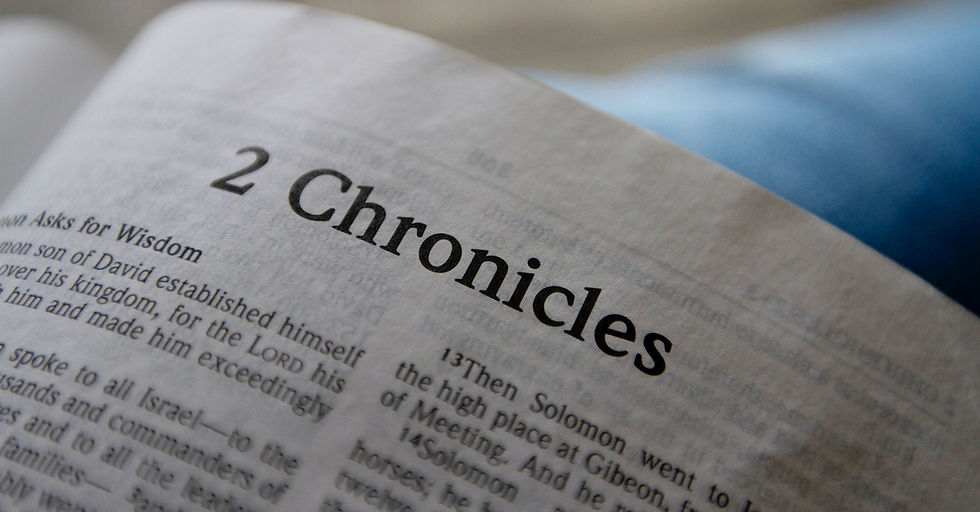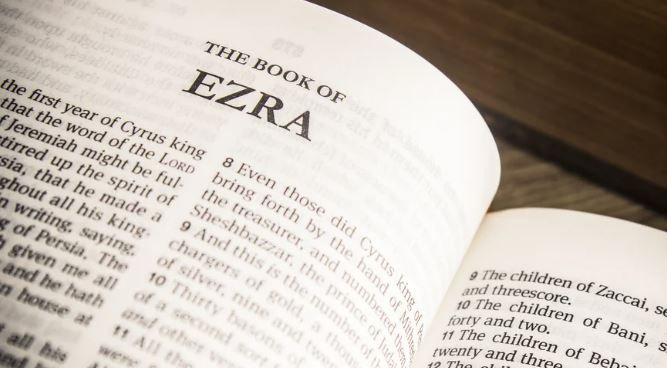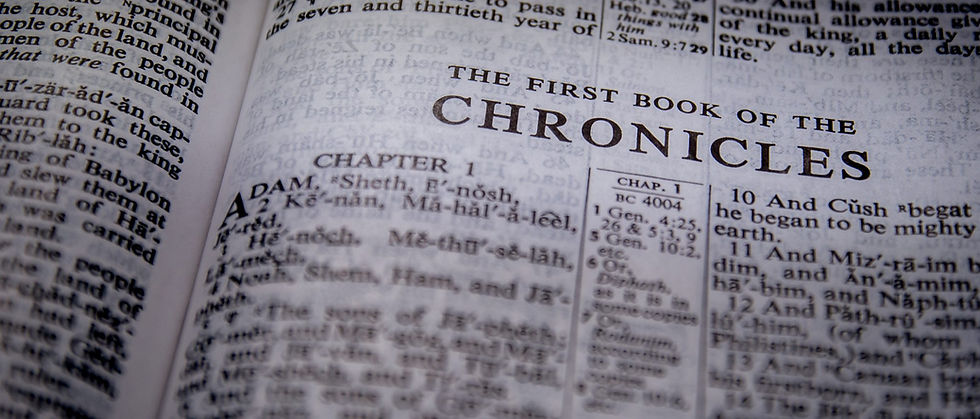2 Chronicles Summary: Faithfulness, Failure, and the Fire That Never Goes Out
- Bible Believing Christian

- Aug 8
- 4 min read

2 Chronicles Summary: Faithfulness, Failure, and the Fire That Never Goes Out
If 1 Chronicles focused on David, then 2 Chronicles centers on Solomon and the kings of Judah, leading up to the Babylonian exile. But this isn’t just another version of Kings. 2 Chronicles retells Judah’s story with a laser focus on the temple, worship, and revival. It ignores the northern kingdom of Israel almost entirely, zooming in on the line of David and the southern kingdom. Written after the return from exile, this book reminded the people: God was faithful then—and He still is. Even in failure, the door to restoration is never closed.
Chronicles was originally one long scroll. It was divided into 1 and 2 Chronicles in the Septuagint, and focuses heavily on the priesthood, temple, and Davidic covenant. Most scholars believe Ezra compiled it as part of a post-exilic encouragement.
Etymology & Background
Hebrew Title: דִּבְרֵי הַיָּמִים ב (Divrei Hayamim Bet) – “The Words (Events) of the Days – Second”
Greek (LXX): Παραλειπομένων Βʹ (Paraleipomenōn Bʹ) – “Things Left Out”
Chapter Movements & Key Events
Chapters 1–9: Solomon’s Wisdom and the Temple of the Lord
Solomon asks God for wisdom.
He builds the magnificent temple in Jerusalem, fulfilling David’s dream.
The Ark of the Covenant is brought in, and God’s glory fills the temple.
“Fire flashed down from heaven and burned up the burnt offerings and sacrifices, and the glorious presence of the Lord filled the Temple.”(2 Chronicles 7:1, NLT)
God reaffirms His covenant:
“If My people who are called by My name will humble themselves and pray… then I will hear from heaven and will forgive their sins and restore their land.”(2 Chronicles 7:14, NLT)
Chapters 10–12: The Kingdom Splits
Rehoboam ignores wise counsel, and the kingdom divides.
Chronicles largely ignores the northern kingdom after this, focusing only on Judah.
Chapters 13–36: A Roller Coaster of Kings
The rest of the book details Judah’s kings—the good, the bad, and the utterly depraved.
Key Kings include:
Asa (Ch. 14–16): Sought God, reformed worship—but relied on human strength later.
Jehoshaphat (Ch. 17–20): Trusted God in battle; prayed before fighting.
Joash (Ch. 24): Started strong under priestly guidance but drifted into idolatry.
Hezekiah (Ch. 29–32): Cleansed the temple, celebrated Passover, trusted God against Assyria.
Manasseh (Ch. 33): Started as the most evil king—but repented! God forgave him.
“Then Manasseh finally realized that the Lord alone is God!”(2 Chronicles 33:13, NLT)
Josiah (Ch. 34–35): Found the Book of the Law and sparked revival.
Zedekiah (Ch. 36): Rejected God's word, persecuted prophets.
Chapter 36: The Fall and the Flicker of Hope
Jerusalem falls. The temple is burned. Exile begins.
But the book does not end in despair:
“But in the first year of King Cyrus of Persia… the Lord fulfilled the prophecy He had given through Jeremiah. He stirred the heart of Cyrus… to rebuild the Temple of the Lord.”(2 Chronicles 36:22–23, NLT)
Chronicles ends with hope—God is not done with His people.
Bridge to Jesus
2 Chronicles builds anticipation for a better King and a greater temple. Even in the ashes of judgment, God leaves a spark of redemption. Jesus fulfills every failed king, every temple hope, and every call to repentance.
How 2 Chronicles Points to Jesus
1. The Temple → Jesus, God With Us
Solomon’s temple was filled with glory. Jesus came as the true Temple—God’s presence in the flesh.
“Destroy this temple, and in three days I will raise it up.”(John 2:19, NLT)
2. The Kings → Jesus, the Righteous King
Chronicles highlights the inconsistencies of Judah’s kings—sometimes faithful, often not. Jesus is the true Son of David, who never fails.
“Look, your King is coming to you. He is righteous and victorious…”(Zechariah 9:9 quoted in Matthew 21:5, NLT)
3. The Call to Repentance → Jesus, the Merciful Savior
“If My people… humble themselves and pray…”(2 Chronicles 7:14, NLT)
Jesus calls for repentance and offers forgiveness, fulfilling the very heart of God’s covenant.
“Repent of your sins and turn to God, for the Kingdom of Heaven is near.”(Matthew 4:17, NLT)
4. The Exile and Return → Jesus, the One Who Brings Us Home
Chronicles ends with Cyrus proclaiming the return to rebuild. Jesus is the greater liberator, bringing us from exile in sin to freedom and restoration.
“So if the Son sets you free, you are truly free.”(John 8:36, NLT)
Application – What Should We Do With This?
1. Worship Like God is Holy
Solomon's temple wasn't built for comfort but for reverence. Don’t take worship lightly.
2. Pray Like Your Nation Depends On It
God told His people to humble themselves and pray. That’s still the call.
3. Don’t Wait to Repent
Manasseh proves it's never too late—but don’t wait that long. Turn back now.
4. Keep Hoping
Even when the temple burned and the kings failed, God’s promises stood firm.Jesus is our temple, our King, and our future.


